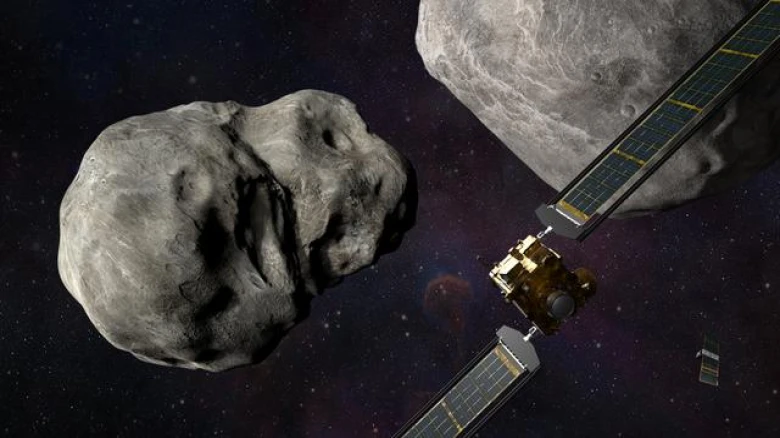Sports

Digital Desk: On Monday, NASA's DART spacecraft slammed into
a distant asteroid at hypersonic speed in the world's first test of a planetary
defense system designed to prevent a doomsday meteorite collision with Earth.
Humanity's first attempt to alter the motion of an asteroid
or any celestial body occurred 10 months after DART was launched, in a NASA
webcast from the mission operations center outside Washington, DC.
The DART camera captured images
as the cube-shaped "impactor" vehicle, no bigger than a vending
machine with two rectangular solar arrays, streaked into the asteroid
Dimorphos, about the size of a football stadium, at 7:14 p.m. EDT (23:14 GMT)
some 6.8 million miles (11 million km) from Earth.
The seven-year-in-the-making $330
million (roughly Rs. 2,683 crores) mission was designed to test whether a
spacecraft is capable of changing an asteroid's trajectory through sheer
kinetic force, nudging it off course just enough to keep Earth safe.
The experiment's success or
failure will not be known until further ground-based telescope observations of
the asteroid are made next month. However, NASA officials praised the
spacecraft's immediate success, saying it served its purpose.
"NASA works for the benefit
of humanity, so doing something like this is the ultimate fulfillment of our
mission - a technology demonstration that, who knows, someday could save our
home," retired astronaut and NASA Deputy Administrator Pam Melroy said
minutes after the impact.
DART, which was launched by a
SpaceX rocket in November 2021, spent the majority of its journey under the
control of NASA's flight directors, with control handed over to an autonomous
onboard navigation system in the final hours.
The bullseye impact on Monday
evening was tracked in near real-time from the mission operations center at the
Johns Hopkins University Applied Physics Laboratory in Laurel, Maryland.
Cheers erupted from the control
room as DART's onboard camera captured second-by-second images of the target
asteroid, which eventually filled the TV screen of NASA's live webcast just
before the signal was lost, confirming the spacecraft had crashed into
Dimorphos.
DART's celestial target was an
oblong asteroid "moonlet" about 560 feet (170 metres) in diameter
that orbits Didymos, a parent asteroid five times larger, as part of a binary
pair called Didymos, the Greek word for twin.
Neither object poses an actual
threat to Earth, and NASA scientists stated that their DART test could not have
accidentally created a new hazard.
Dimorphos and Didymos are both
insignificant in comparison to the cataclysmic Chicxulub asteroid, which struck
Earth 66 million years ago and wiped out roughly three-quarters of the world's
plant and animal species, including dinosaurs.
According to NASA scientists and
planetary defense experts, smaller asteroids are far more common and pose a
greater theoretical concern in the near term, making the Didymos pair suitable
test subjects for their size. While not capable of posing a global threat, a
Dimorphos-sized asteroid could level a major city with a direct hit.
Furthermore, the two asteroids' proximity to Earth and dual
configuration make them ideal for the first DART, or Double Asteroid
Redirection Test, proof-of-concept mission.
The mission was a rare instance in which a NASA spacecraft
had to crash in order to succeed. DART collided with Dimorphos at 15,000 miles
per hour (24,000 kilometers per hour), creating the force that scientists hope
will be enough to shift the asteroid's orbit closer to the parent asteroid.
Leave A Comment